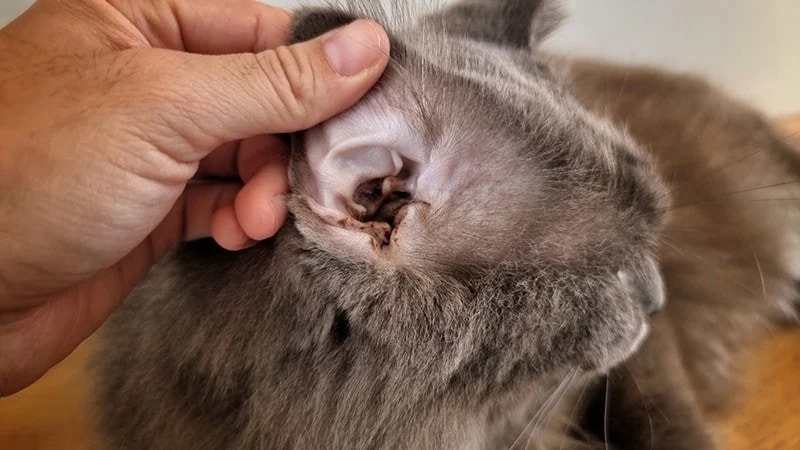
- 1. Understanding Pet Ear Tumors
- 2. Symptoms of Ear Tumors in Pets
- 3. Diagnosing Ear Tumors in Pets
- 4. Treatment Options for Ear Tumors
- 5. Preventing Ear Tumors in Pets
- 6. Real-Life Cases of Pet Ear Tumors
1. Understanding Pet Ear Tumors
Ear tumors in pets are abnormal growths that can develop in the external ear canal, middle ear, or even within the inner ear. While they are not as common as other types of tumors, they can still pose a significant threat to your pet's health if left untreated. These tumors can affect both dogs and cats, with varying causes ranging from genetics to environmental factors. It is crucial to be aware of the possibility of ear tumors in your pet so you can take timely action to detect and treat them.
Ear tumors in pets typically fall into two categories: benign and malignant. Benign tumors are non-cancerous and may not cause significant health issues, but malignant tumors are cancerous and can spread to other parts of the body, which is why early detection and proper management are critical.
2. Symptoms of Ear Tumors in Pets
Recognizing the symptoms of ear tumors in pets is key to detecting them early. Some of the most common signs to look out for include:
- Excessive scratching or pawing at the ear: Pets may scratch at the affected ear due to discomfort or irritation caused by the tumor.
- Head shaking: Frequent shaking of the head can indicate an issue within the ear, including the presence of a tumor.
- Unusual odor or discharge from the ear: A foul-smelling discharge, often accompanied by a thickening of the ear canal, can be a sign of an infection or tumor.
- Swelling or lumps in the ear canal: Palpable lumps or swelling in or around the ear canal may indicate a growth, such as a tumor.
- Changes in behavior: Pets with ear tumors may exhibit signs of pain, discomfort, or even aggression due to the physical discomfort of the tumor.
If you notice any of these symptoms, it's essential to consult with a veterinarian for further evaluation and diagnosis.
3. Diagnosing Ear Tumors in Pets
Once you observe symptoms of ear tumors in your pet, your veterinarian will conduct a thorough examination to confirm the presence of a tumor. Diagnosing ear tumors typically involves several steps:
- Physical examination: The vet will carefully inspect your pet's ear canal and surrounding areas to check for swelling, lumps, or other abnormalities.
- Ear swabs and tests: A sample of the ear discharge may be taken to determine whether there is an infection or other issue.
- X-rays or ultrasound: To assess the size and extent of the tumor, imaging techniques like X-rays or ultrasound may be used, especially if the tumor is suspected to be malignant.
- Biopsy: In some cases, a biopsy may be necessary to determine whether the tumor is benign or malignant.
Once the diagnosis is confirmed, your veterinarian will recommend the appropriate course of treatment based on the type and severity of the tumor.
4. Treatment Options for Ear Tumors
Treatment for pet ear tumors varies depending on whether the tumor is benign or malignant, as well as its size, location, and overall impact on your pet's health. Some of the common treatment options include:
- Surgical removal: If the tumor is localized and accessible, surgery is often the preferred option. This involves removing the tumor and possibly part of the ear canal to ensure complete removal.
- Radiation therapy: In cases of malignant tumors, radiation therapy may be used to shrink the tumor or prevent it from spreading to other areas of the body.
- Chemotherapy: For more aggressive malignant tumors, chemotherapy may be recommended to treat the cancerous cells.
- Supportive care: In addition to medical treatments, supportive care such as pain management and anti-inflammatory medications can help ease your pet's discomfort during recovery.
It's important to work closely with your veterinarian to determine the most appropriate treatment plan based on your pet's specific condition.
5. Preventing Ear Tumors in Pets
While not all ear tumors are preventable, there are several steps you can take to help reduce your pet's risk of developing them:
- Regular ear cleaning: Regularly cleaning your pet's ears can help prevent infections and the buildup of wax, which could contribute to the development of tumors.
- Routine veterinary checkups: Regular visits to the vet can help catch potential health issues, including ear tumors, before they become serious.
- Minimize exposure to environmental toxins: Avoiding exposure to harmful chemicals and pollutants can help reduce the risk of cancerous tumors in your pet.
- Genetic screening: If you have a breed predisposed to ear problems, such as certain types of dogs with floppy ears, consult with your veterinarian about genetic screening and preventive care.
6. Real-Life Cases of Pet Ear Tumors
One of the most notable cases of ear tumors involved a Labrador retriever named Max. Max's owner noticed he was excessively scratching his ears and shaking his head. After several veterinary visits, it was discovered that Max had a benign ear tumor. The tumor was successfully removed through surgery, and with post-operative care, Max recovered fully and went on to live a healthy, happy life.
On the other hand, a case involving a Siamese cat named Bella highlighted the dangers of ignoring ear health. Bella's owners initially thought her ear discomfort was simply due to an infection, but after weeks of ineffective treatment, it was found that Bella had a malignant ear tumor. Unfortunately, due to the advanced stage of the cancer, Bella's prognosis was not favorable. This case emphasizes the importance of early detection and prompt veterinary care.
At Pet & Puppy, we offer a range of products and services that can help monitor your pet's health, including ear care supplies and access to trusted veterinary professionals who can assist with diagnosing and treating ear tumors.









 PetVet Vaccination Clinic0.0 (0 reviews)
PetVet Vaccination Clinic0.0 (0 reviews) Banfield Pet Hospital4.0 (157 reviews)
Banfield Pet Hospital4.0 (157 reviews) Veterinary Medical Center of Fort Thomas4.0 (49 reviews)
Veterinary Medical Center of Fort Thomas4.0 (49 reviews) Pet Planet Cooley Station4.0 (31 reviews)
Pet Planet Cooley Station4.0 (31 reviews) PetVet Vaccination Clinic5.0 (1 reviews)
PetVet Vaccination Clinic5.0 (1 reviews) Pet Supermarket4.0 (413 reviews)
Pet Supermarket4.0 (413 reviews) How Often Should You Change Your Pet’s Diet? A Vet’s View
How Often Should You Change Your Pet’s Diet? A Vet’s View What Breed-Specific Health Issues You Should Be Aware Of
What Breed-Specific Health Issues You Should Be Aware Of Behind the Scenes of a Veterinary Clinic: What Happens in 24 Hours
Behind the Scenes of a Veterinary Clinic: What Happens in 24 Hours How to Keep Your Dog Comfortable with Hot Spots - Causes, Treatment & Care
How to Keep Your Dog Comfortable with Hot Spots - Causes, Treatment & Care Pet Insurance 101: What It Covers & When It Pays
Pet Insurance 101: What It Covers & When It Pays Leash Pulling in Dogs: Causes & Effective Correction Techniques
Leash Pulling in Dogs: Causes & Effective Correction Techniques